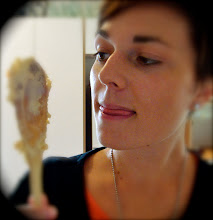 I wanted to call this post eating violetly... but was concerned that it may be misread, and as it turns out, there is nothing violent about the eating of violets... unless you have to wrest them from your little-old-lady neighbour (we have an almost shared front yard and 'differing opinions' on flowers as food). 'Nuff said.
I wanted to call this post eating violetly... but was concerned that it may be misread, and as it turns out, there is nothing violent about the eating of violets... unless you have to wrest them from your little-old-lady neighbour (we have an almost shared front yard and 'differing opinions' on flowers as food). 'Nuff said. *Disclaimer: no LOL's were harmed during this taste test.
Moving around the world of food and learning to be open to the reality of the nourishment around me brings new and unusual additions everyday. It's a great adventure that leads to some astonishing discoveries- and plenty of questions. And the one I constantly find myself asking is 'what the hell happened to our food?'- why, in a time so fraught with ecological questions and food sustainability issues, do we insist on shrinking the variety of the things we call 'edible'?
Researching and taste-testing violets brought me up against a whole range of resistance to eating the leaves. From the 'garden flowers aren't food' argument, to the 'it didn't come from the supermarket' kind, I was surprised at the confused responses to this perfectly edible plant.

After all, everyone knows you can eat sugared violet flowers... but the leaves... really? The answer: Yes. Really.
Historically they have been used for everything from treating cancer to aiding weight-loss, but somewhere along the way we forgot that they were also a nutritious addition to the diet.
Violets are high in iron, calcium and (as with any wild plant) anti-oxidants. Both the leaves and flowers of white, purple and blue violets are edible (yellow violets are not edible) and they make a tasty and pretty addition to salads, but are equally delicious on their own. Another great chance for some variety in your greens.
The flowers have a strong violet-y flavour when their perfume hits your palate and it's a surprisingly appealing taste sensation. The leaves are a little peppery and cause a slight tingle on your tongue.
For dinner, they make a great side salad of fresh baby leaves, any flowers on the bush and a bit of light dressing (olive oil, lemon and salt work well). But they are even better tossed through seasonal greens for a bit of an unusual lift.
So just as long as I can keep sneaking past the LOL next door, I'll get my fix of salad violets and keep my salads pretty.
*Note: as with any plant you intend to eat from your garden, it is essential that you positively identify it as the species and variety that you are after before you attempt to eat it and always wash it thoroughly.





 have access to fresh, seasonal produce- sometime you just gotta drown yourself in it, and with over 600 beautiful and lovingly gathered chestnuts adorning my house in little bowls and mountains, it was time to start putting them to good use.
have access to fresh, seasonal produce- sometime you just gotta drown yourself in it, and with over 600 beautiful and lovingly gathered chestnuts adorning my house in little bowls and mountains, it was time to start putting them to good use.
















